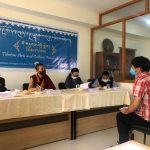In the area of preservation of Tibetan arts and culture, CTA currently has four major initiatives: the Tibetan Institute of Performing Arts, establishment of the new Tibet Museum, setting up the new Himalayan Buddhist Library and Cultural Center in Nepal, and the establishment of a Tibetan Arts and Culture Fund.
Tibetan Performing Arts Revitalization: Founded by His Holiness the Dalai Lama in 1959, the Tibetan Institute of Performing Arts (TIPA) in Dharamsala is the most prominent institution in exile preserving Tibetan classical performing arts, folk song and dance traditions, and traditional opera. The institute currently employs 50 performing artists, composers, choreographers, and production staff, and stages performances in India and abroad. CTA provides support for pre and in-service training for TIPA artists, training for local opera association artists, a traditional opera festival and facility improvements. A major assessment of the organization and its program was undertaken in 2017 and a strategic roadmap for strengthening TIPA was developed.
Tibet Museum: The current Tibet Museum located adjacent to the main temple in upper Dharamsala is tiny, has a limited focus in terms of content, and does not have an archive section. However, it still attracts close to 80,000 visitors a year. There is an urgent need for a larger museum and program expansion. The CTA is constructing a new Tibet Museum located in the CTA campus in Dharamsala.
This largest museum of its kind in the Tibetan community will educate visitors on Tibet’s history and culture to promote better understanding and appreciation. It will serve as a repository of cultural and historical artifacts and celebrate what is unique about Tibet and Tibetan culture.
Tibetan Arts and Culture Small Grants Fund: The Department of Religion and Culture established a Tibetan Arts and Culture Fund. The fund invites applications from Tibetans working in areas of both traditional and contemporary arts and culture, including metal work, painting, sculpture and carving, music, dance, astrology, medicine, the literary arts, and Tibetan language. Grants ranging from $750 to $10,000 are awarded for specific projects or as support to individual practitioners. In the first year of the program in 2017, the program received over forty applications and grants were awarded to thirteen organizations and artists.
Himalayan Buddhist Library and Cultural Center: In Nepal a cultural center is being established with the mission of preserving Tibetan-Himalayan cultural heritage and strengthening cultural ties between Tibetan and Himalayan communities. The new center will house a library and will organize cultural events, lectures and seminars, offer language classes, award cultural research fellowships, etc. The possibility of establishing such a center in either Kathmandu or another location in Nepal is being actively explored.






